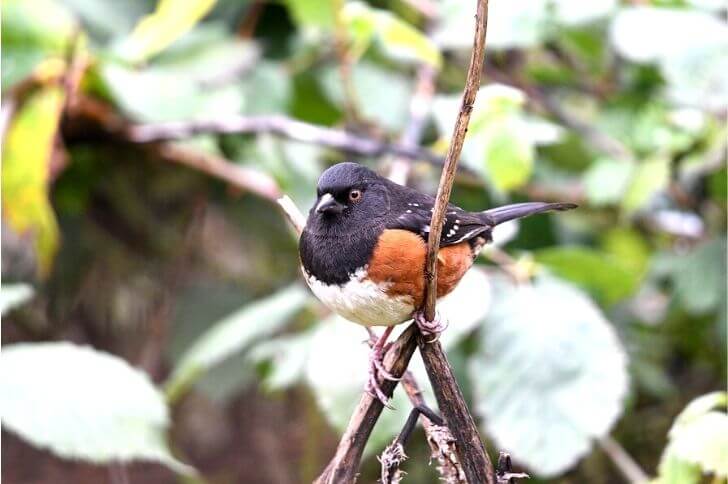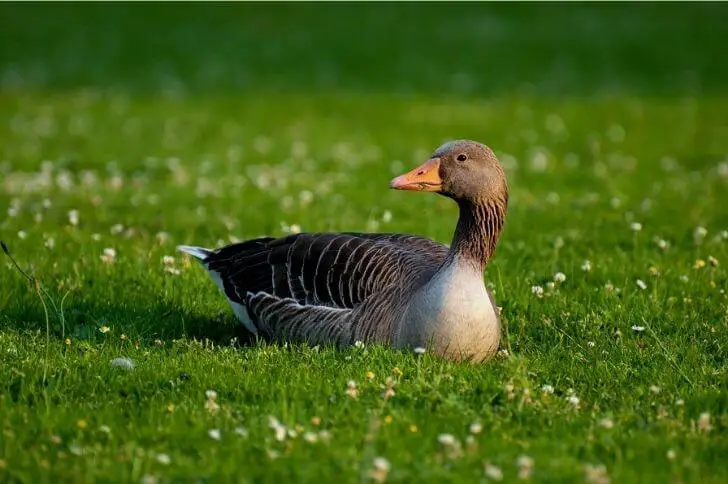Spanish birds are some of the most colorful and well-known in the world. They range from the small songbirds to the big, impressive raptors. Some of the most common and well-known birds of Spain include the house sparrows, porchards, eagles, swifts and hummingbirds. There is a wide variety of birds found in Spain, from coastal seabirds to woodland creatures
Whether you’re looking for a unique bird to add to your backyard or just want to learn more about their habits, this article will be an invaluable resource. We’ll discuss some of the most interesting, with a wide variety of sizes, shapes, and plumages. Some of the best birds of Spain to watch include:
List of Birds of Spain
1. Iberian Imperial Eagle (national bird)

It’s only right we start this list of birds with the national bird of Spain, the Iberian Imperial Eagle. It is a critically endangered bird of prey and is endemic to the Iberian Peninsula. There are only about 350 individuals left in the wild. The main threats to the species are loss of habitat and hunting.
Interesting Facts
The Spanish Iberian imperial eagle is a large raptor with a wingspan of 5 – 7.5 Feet and weighs up to 10 lbs. It is dark brown with a white band on their shoulders. It has a long, hooked bill and powerful talons.
This powerful eagle feeds mainly on rabbits, hares, and small deer. It also eats birds, reptiles, and insects. It hunts by soaring high in the air and then diving down on its prey.
When it comes to breeding, conservation measures have been put in place to help increase their numbers. When breeding they prefer mature woodlands where they build huge nests and lay up to 3 eggs. Incubation lasts up to 43 days. The imperial eagle scientific name is Aquila adalberti.
2. White-headed duck of Spain

The white-headed duck is a small to medium-sized dabbling duck. It is one of the members of the genus Oxyura which also includes lake ducks and ruddy ducks.
Interesting Facts:
Scientific names: Oxyura leucocephala
Length: Up to 19 inches
Weight: up to 16 lb
Wingspan: 24 – 28 inches
These bird species are sexually dimorphic with males having a reddish-gray body and a white head with blue bill. Females are mostly gray-brown with a darker bill.
Like other ducks, they are excellent swimmers and mostly feed on plants.
3. House sparrow

Interesting facts:
Scientific name: Passer domesticus
Size: 6.3 inches
Weight: 1.3 oz
Wingspan: 7.5 -10 inches
The house sparrow is a small, plump bird that is found throughout the world. It is a common sight in cities and towns of Spain, where it scavenges for food in the streets and parks. The house sparrow is a social bird that lives in large flocks. It is a prolific breeder, and its eggs and young are preyed on by many different animals. This small bird is a nuisance.
4. Bearded vulture

Another interesting bird of prey is the bearded vulture. Are bearded vultures rare? Yes, according to statistics there are about 500 pairs in the wild.
Mostly found in mountain ranges, this large black bird species of prey is an unmistakable bird.
Interesting facts:
Science name: Gypaetus barbatus
Weight: up to 17 lb
Wingspan: 7 – 9.5 inches
Size: 37 – 50 inches
What is unique about a bearded vulture? Unlike other birds of this species it doesn’t spot a bald patch on their head. Also another unique feature is its narrow black wings which you can easily spot when it’s on flight. Its neck has thick feathers which gives it a beard appearance.
Spanish bearded vultures are scavengers and feed on the carcasses of dead animals. Breeding season starts in December.
5. Sandhill crane

Bird ID:
Name: Antigone canadensis
Wingspan: 78 inches
Size: 47 inches
Height: 5 feet
Weight: 10 lb
Among crane birds, you’ll find the sandhill crane. With its long graceful legs and long neck, this Spanish bird is easy to identify.
These birds can be found in open areas near water, such as marshes, prairies, and fields. They are usually seen in small flocks, but sometimes gather in large groups during or winter. Sandhill cranes feed on a variety of plants such as corn and sorghum. They are known for their loud trumpeting calls, which can be heard from long distances.
6. Domestic canary

Bird ID:
Science name: Serinus canaria forma domestica
Wingspan: 7 -9 inches
Weight: 0.7 oz
Size: 4 inches
Endemic to canary islands, the domestic canary is a small passerine bird in the finch family. It is a common pet in homes throughout spain. This small Spanish bird has been bred selectively for color and song since the 17th century. There are many different breeds of domestic canary, including several varieties of yellows, reds, and whites.
The domestic canary is a very social bird and thrives when kept in pairs or groups. They are usually quiet birds but may sing frequently during the day. Domestic canaries eat insects and a variety of seeds and fruits.
The average lifespan of a domestic canary is about 10-15 years, though some have been known to live for up to 20 years. They are relatively easy to care for and make good pets for people of all ages. The domestic canary is one of the most common finches in spain.
7. Iberian crested lark

Bird ID:
Bird name: Galerida cristata
Wingspan: 10 – 15 inches
Weight: 1.9 oz
Size: 6.7 inches
The Iberian crested lark is a passerine bird in the lark family. It is found in open country in southern spain. The Iberian crested lark is about 6.7 inches long with a wingspan of up to 15 inches. The sexes are similar, but juveniles are somewhat duller than adults.
This bird species breeds in open areas with short grass or bare ground, such as fields, pastures, steppes, and coastal dunes. It builds a small cup-shaped nest from grasses or other plant material and lays 3-5 eggs. For up to 15 day, both sexes take turns caring for their eggs.
8. Pin-tailed sandgrouse

source: rodrigomarinag
The pin-tailed sandgrouse is a medium-sized bird that can be found in many parts of the world including Spain. They are known for their unique coloring and their ability to flock watering holes early in the morning.
These western europe birds measure up to 15 inches in length and live in habitats that have sandy soil, and eat seeds and insects. Pin-tailed sandgrouse are monogamous, with the incubation period lasting up to twenty five days.
9. Little bustard

source: meghitheornithologist
Some bird names are pretty unique and the little bustard is a good example. The little bustard is a bird that is found in parts of Europe and Asia. They are a ground-dwelling bird and are brown in color with black and white markings on their head and neck.
Females have different plumage, mostly mottled brown with no markings. Little bustards can be found in open fields and grasslands.
10. Lesser kestrel

source: j.overkamp
Found in mainland Spain, the lesser kestrel is a small falcon that measures up to 13 inches. It is one of the most common birds of prey in spain. The lesser kestrel feeds mainly on insects, but will also eat mice and small birds.
It nests in colonies and builds its nest out of sticks and leaves. The female lays between 2 and 4 eggs, which are incubated by both parents.
11. Balearic shearwater

source: thenaturedetectives
Balearic shearwater is a species of seabird that was first described in the early 1900’s. They have a wingspan of up to 35 inches.
Where do balearic shearwaters live? They favor coastal cliffs and islands. Breeding takes places in nests built in caves and burrows. These spain birds are dark brown in color with a white underside and have a long, slender beak. They are monogamous birds and mate for life. The Balearic shearwater feeds on fish, crustaceans, and squid. From Northern Spain to the south, there are plenty of places to see this unique bird.
12. Great bustard
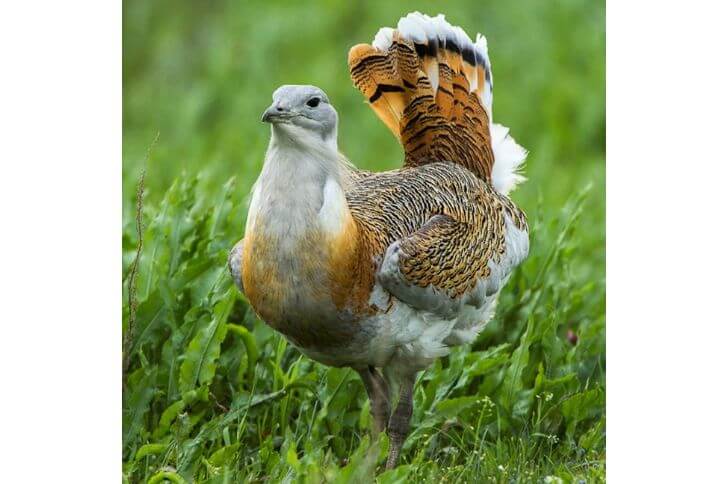
Source: beyourownbirder
Great bustards are migratory birds that can be found in Asia and winter in Europe. According to statistics, Portugal and Spain have the highest population, about 60% of the great bustard population.
They are one of the heaviest flying birds in the world and can weigh up to 35 pounds. They are ground nesters and eat a variety of plants and insects. They are considered a vulnerable species due to hunting and loss of habitat.
13. Dupont’s lark

Named after a French naturalist, the Dupont lark was first described in the early 1800s. Measuring about 8 inches, this medium-sized bird repeated whistling phrases.
Both sexes share similar features and plumage. They are heavily streaked on their back with whitish bellies. Dupont’s lark clutch includes 4 eggs.
14. Audouin’s gull

Elegant and beautiful, the audouin’s gull is one of the rarest gulls in the world. With a population of about 10000 birds, getting a glimpse of this rare bird would be a great win for any birding enthusiast.
This seabird breeds on the coasts of spain. It is a medium-sized gull, with a length of 20 inches, a wingspan of 51 inches, and a weight of 1.3 lb. The adult has a white head and underparts, grey back and wings, reddish- black bill and legs. The juvenile is mottled brown with dark streaks.
15. Iberian chiffchaff

One of the most common inland species in Spain is the Iberian chiffchaff. It is a member of the Leaf warbler family, and is closely related to the common chiffchaff.
The Iberian chiffchaff is very difficult to distinguish from the common chiffchaff, but can be identified by its slightly darker coloration and by its song, which is more melodic than the song of the common chiffchaff. This small bird is a joy to watch.
16. Bonelli’s eagle

source: lumafotos.es
Bonelli’s eagle is a large, dark brown raptor with a wingspan of up to 5 ft. It is found in open countries throughout Europe. The Bonneli eagle preys mainly on rabbits, hares, and other small mammals. It nests in tall trees or on cliffs, laying one or two eggs.
So how can you identify this bird species? This large bird of prey has dark wings and a streaked underside.
17. Chimney swift

Gregarious and dull, chimney swifts are some of the most common birds in spain. Like other swift they are great at air acrobatics.
The chimney swift is a dark bird species and can often be mistaken for a swallow. These birds are unique in that they spend their entire lives in the air, never landing on the ground.
They eat, sleep, and mate while flying. Chimney swifts build their nests out of twigs and attach them to chimneys or other vertical surfaces.
18. Common pochard
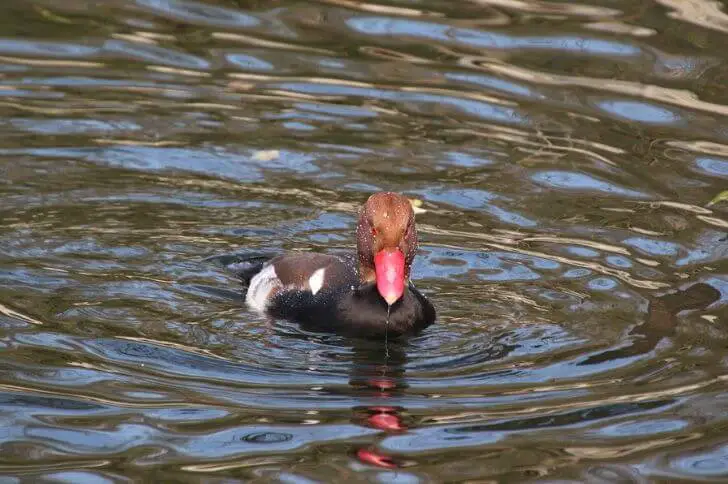
The common pochard is one of the types of ducks in spain. This medium-sized diving duck can be found in many parts of the world.
They are sexually dimorphic birds. Males have a pale grayish body, black bill, and rusty head. Notices its stunning red eyes. Females are easily recognizable because of their distinctive gray-brown body. The common pochard feeds on a variety of aquatic plants and animals, and can often be seen swimming or diving for food. Although it is not considered to be an endangered species, the common pochard population has been declining in recent years.
19. Eurasian wigeon

Favoring marshes and wet grasslands with tall vegetation, the Eurasian wigeon is a 20-inch waterbird that is one of the endemic species of spain. It can also be found in other countries across Europe.
This Spanish duck can be easily mistaken for the common pochard. But, you can easily tell the difference by looking at its bill. The pochard’s bill is black while the Eurasian’s wigeon is whitish.
20. Pink footed goose

The bobby bird is not the only bird with funky looking feet. Boasting gorgeous pink feet, this goose of Spain is a migratory bird that breeds in the tundra of Scandinavia and Russia and winters in the United Kingdom, Ireland, and other parts of Europe.
These birds are about 25 inches long with a wingspan of 50 inches. They weigh between 2 and 4 pounds. The adult male has brown gray body, a light brown head and a pink-black bill.
21. Mute swan

Mute swans are a beautiful and graceful bird that can be found in many parts of the world including spain. They are large, white birds with a long neck and bill. Swans can be identified by their black markings on their heads and red-orange bills.
Mute swans are not mute, but they got their name because they were once considered the most silent of all birds. They are known for grunting and snorting sounds. They can be quite aggressive.
22. Stock dove
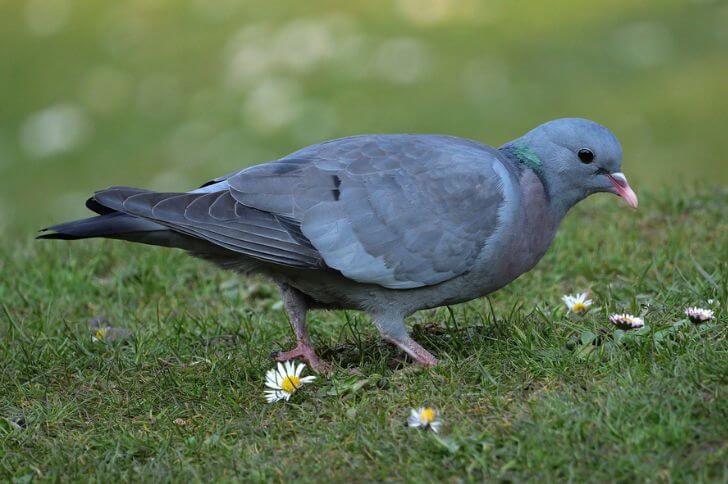
Pigeons are some of the most common birds of spain. The stock dove is part of this family and are scarce compared to their relatives. They are mostly gray on their back and a small gray head with a pink bill. Notice the pink feet.
This shy bird lives in pairs or in small groups. It’s vocals include a series of hoarse coos. Stoke doves nest in holes in tree.
23. Great-spotted cuckoo

Source: yosef.ribeiro
Great spotted cuckoos are birds that are members of the Cuculidae family which includes hawk cuckoos and long-tailed cuckoos. The great spotted cuckoo is distributed in Spain and is mostly known as a brood parasitic habit.
It lays its eggs in other birds nests which are then incubated by the owner of the nest. The young cuckoos are raised by the host birds. The adult great spotted cuckoos are approximately 14-15 inches in length and have a long narrow tail. The adult great spotted cuckoos are black with white spots on their wings and white undersides.
24. Corn crake
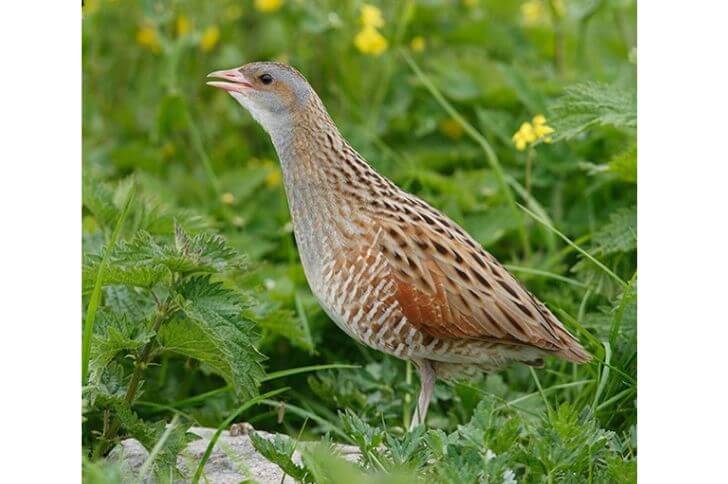
source: nigelblake7464
Do corn crakes fly? Also known as land rail, corn crakes can fly up to 50 m at a time but they prefer staying on the ground. You’ll hardly see them flying unless they are in danger.
The corn crake is a medium-size brown bird that is a member of the rail family, which also includes the coot and the moorhen. The corn crake is a shy bird that prefers to stay hidden in dense vegetation. It feeds on insects, worms, and other small creatures.
25. Pied avocet
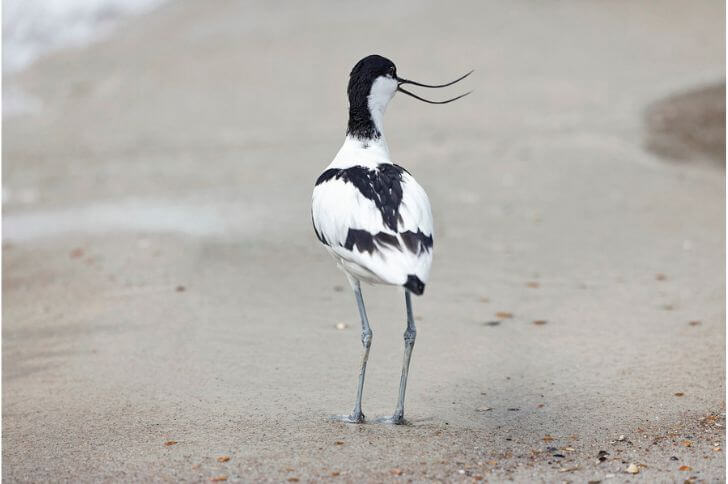
What is a avocet? The pied avocet is a unique bird with an upward curved long bill. This striking bird is mid-sized with beautiful black and white plumage.
It can be found in marshes and wetlands where it forages for crustaceans. These wading birds have long legs and a long neck. Pied avocets are considered to be a threatened species, and conservation efforts are underway to help protect them.
26. Whimbrel

The whimbrel is a migratory bird that can be found in North America and Europe. They are known for their long, curved beaks which they use to catch fish, crabs, and other small creatures.
Whimbrels typically weigh around one pound and are about 19 inches in length. They are brown or black with long graceful feet.
27. Bufflehead

Buffleheads are small diving ducks that are easy to identify because of their unique head shape. Buffleheads are white on the top, a dark back and white on the bottom. Their face is purple-greenish.
Females are duller with a round head. They are a migratory bird and can be found in many different habitats, including wetlands, rivers, and lakes. Buffleheads eat mainly aquatic insects and plants, but they will also consume small fish and crustaceans.
28. Mourning dove
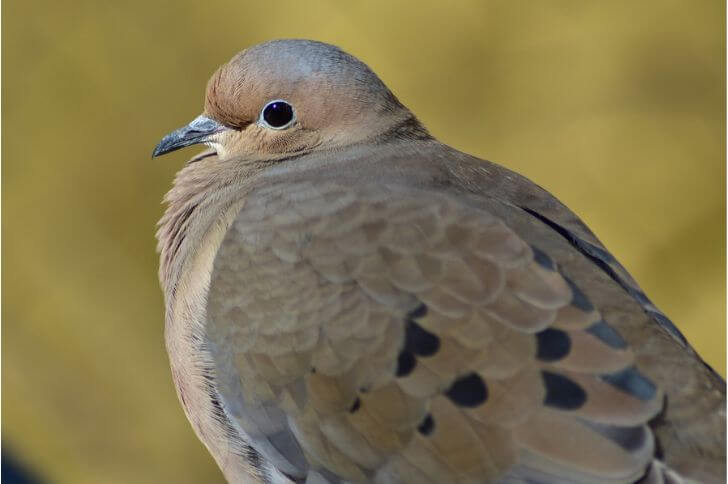
The mourning dove is a small, brown bird that is found throughout Spain. These birds are well known for their gentle nature and song.
Mourning doves can be identified by their long, pointed wings and light-colored underparts. These birds prefer eating seeds, and insects. In the winter, mourning doves migrate to warmer climates.
29. Dunlin bird

Dunlin birds are a small shorebird that can be found in Eurasia. They are usually about 6 – 8 inches long and have a wingspan of about 13-15 inches. Dunlins are a mottled brown with a white belly and sides.
They have a long, thin bill that is perfect for catching small fish and aquatic insects. Dunlins live near the water’s edge and use their sharp eyesight to watch for predators and prey.
Final Thoughts on Spanish Birds
In conclusion, the birds of Spain are some of the most beautiful and varied in the world. With over 400 different species, there is a bird to suit everyone’s taste. From the tiny finch to the majestic eagle, the birds of Spain are sure to delight and amaze. So get out there and start bird watching today!
Sources:
https://en.wikipedia.org/wiki/White-headed_duck
https://www.wildlifetrusts.org/wildlife-explorer/birds/pigeons-and-doves/stock-dove
Hi fellow bird watcher. Welcome to our small corner of the world. At the spanishbirdguides.com our mission is to share with other bird watchers the things we love about birds, where to go bird watching within the United States, and more. I’d also love to hear from you. Feel free to contact me about your bird watching escapades, share videos, photos and more.
